|
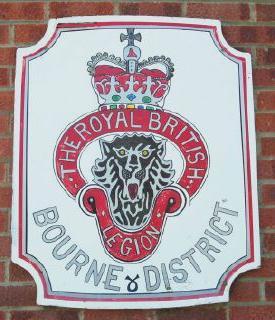 |
The Royal
British
Legion
BOURNE BRANCH
formed 1924
|
The Royal British Legion is the leading charity in the United Kingdom, safeguarding the welfare, interests and memory of those who have served in the armed forces and their dependants. It provides financial, social and emotional support to millions and its benevolence spans all age groups from the oldest to the very young.
The story of the British Legion began in Flanders and Picardy, in northern France and Belgium, which saw some of the most concentrated fighting of the First World War of 1914-18. There was complete devastation. Buildings, roads, trees and natural life simply disappeared. Where once there were homes and farms there was now a sea of mud. But still the poppy flowered every year with the coming of the warm weather and brought life, hope, colour and reassurance to an otherwise devastated place.
John McCrae (1872-1918), a doctor serving with the Canadian Armed Forces, was so deeply moved by what he saw in northern France that, in 1915, in his pocket book, he scribbled the following verses:
|
In Flanders fields the poppies blow
Between the crosses, row on row,
That mark our place; and in the sky
The larks, still bravely singing, fly
Scarce heard amid the guns below.
We are the Dead. Short days ago
We lived, felt dawn, saw sunset glow,
Loved and were loved, and now we lie
In Flanders fields.
Take up our quarrel with the foe:
To you from failing hands we throw
The torch; be yours to hold it high.
If ye break faith with us who die
We shall not sleep, though poppies grow
In Flanders fields. |
McCrae's poem was eventually published in Punch magazine and civilians around the world began to realise the full horror of the war in France, and in the trenches. McCrae died in 1918 in a military hospital on the French Channel coast. Shortly before he died he is said to have murmured:
|
Tell them this, if ye break faith with us who die, we shall not
sleep. |
In 1918, on the Eleventh Hour of the Eleventh Day of the Eleventh Month, the First World War ended. Thousands had died, thousands more had been injured and scarred by their experiences. The men and women who had survived returned to their homes. For them though, the world would never be the same. Moina Michael, an American War Secretary with the YMCA and a writer, was moved by McCrae's work and she wrote:
|
And now the torch and Poppy red
Wear in honour of our dead |
Miss Michael bought red poppies with money that had been given to her by work colleagues, and wearing one of the poppies she had bought, sold the remainder to her friends to raise a small amount of money for servicemen in need. A French colleague, Madame Guerin, encouraged by what Moina Michael had achieved with the poppy emblem, proposed the making and sale of artificial poppies to help ex-servicemen and their families. And so the tradition began.
In Britain, Major George Howson, an infantry officer decorated for bravery, was also deeply moved by the plight of ex-service people who seemed unemployable in peacetime. He formed the Disabled Society to help them. The British Legion - now The Royal British Legion - was formed in 1921 to give practical help and companionship to ex-Service people and their dependants. Howson thought the making of artificial poppies might offer opportunities for the Disabled Society and approached the Legion with his suggestions. And so the Royal British Legion factory was established employing many disabled people making poppies, wreaths and other items associated with the appeal. The first Poppy Day was held in Britain on 11 November 1921 and since then it has become a key annual appeal in the nation's calendar.
Branches of the British Legion were soon springing up in every town and city in
Britain and a branch was established in Bourne in 1924. The first attempt
began with a meeting on Friday 11th May 1923 at the Ex-Servicemen's
Clubroom on the Abbey Lawn called by local solicitor, Major Cecil Bell,
who was organising secretary for the East Midlands area. He outlined the
work of the British Legion and the benefits it would bring to former
servicemen in the town but the meeting was poorly attended and after a
short discussion, it was decided to postpone further consideration on the
matter until a later date.
The following year, four local ex-servicemen headed by Mr Edward Lane held a meeting at Baldock's
Mill and the Bourne branch came into being. The others who attended were Jack Baldock, Jack North and Richard Pattison. Originally, Bourne was a sub-branch along with ten others in the area that extended to the Deepings in the south, Castle Bytham in the west and Billingborough in the north but by the early 1950s, membership had grown considerably and the organisation became consolidated as the Bourne and
District branch.
Annual dinners became a regular event, starting at the Corn Exchange in 1926, and in 1934, more than 300 old comrades sat down under the chairmanship of Alderman T W Atkinson with a number of speakers with civic and service backgrounds. The dinners continued as a popular occasion in the legion year but attendance declined and they ceased in 1958.
One of the strengths of the Bourne branch during the past two decades is its social club which was opened in 1980. In the days following the Armistice of 1918, an ex-servicemen's centre had been established in an old army hut erected on the Abbey Lawn and it flourished for some years but interest waned and it closed
in the winter of 1923. The building was used for a time as a meeting hall by the Salvation Army but when they moved out to other premises in West Street, the hut was demolished. There was then no obvious place for a permanent British Legion social headquarters when the possibility was mooted in 1949 and with no other suitable premises available in the town, it was six years before inquiries were made about taking over the East Midlands Electricity Board's social club premises in Burghley Street after rumours had circulated in the town that it might close but no firm undertaking could be obtained and so the idea was shelved.
Undeterred, a special committee was formed in September 1955 to raise funds and explore other possible sites for a new club but it never materialised and the committee disbanded and the £450 accrued was invested in a reserve fund in case the idea came to fruition at a later date. A quarter of a century after the first approach to the East Midlands Electricity Board, negotiations were successful and members moved into their social club premises in Burghley Street which was officially opened on 22nd October 1980 by the president, the Earl of Ancaster. Appropriately the first club steward was Mr Alf Lane whose father had been a founder member of the branch in the years following the Great War and although he retired in 1987, the club continues to flourish.
|
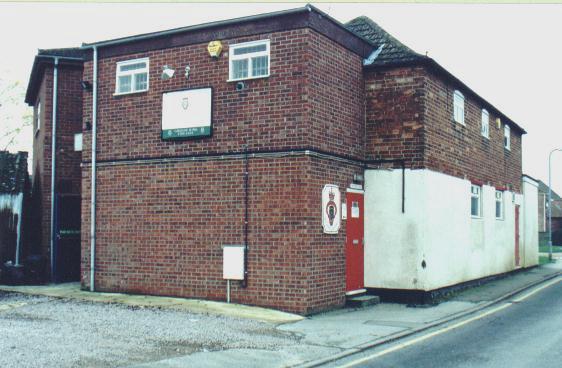 |
The Royal British
Legion headquarters and social club in Bourne, once an old corn
warehouse with a frontage on to Burghley Street, but with later
additions to the side and the rear to provide the modern
facilities required under the regulations for a licensed bar and
social club |
The branch is always keenly aware of its origins and organises an annual united service of remembrance at the Abbey Church on the Sunday nearest to November 11th, firstly with the co-operation of Bourne Urban District Council, disbanded in 1974, and now Bourne Town Council, founded in the same year, and these occasions have been an outstanding success. Since 1966, a member has been chosen to read the lesson at this service and the branch was well represented at the unveiling of the War Memorial in South Street on Sunday 16th September 1956 when members formed a guard of honour with the band of the Lincolnshire Regiment in attendance.
There has also been an active women's section that began in March 1926 and has been in existence ever since and the current president is the late Lord Ancaster's daughter, Baroness Willoughby de Eresby. Members have also been well represented at other events in the county and country. Charles Sharpe, a local man who won the VC in 1915, was a member for many years and on occasions carried the standard and was
one of the Guard of Honour formed by Bourne at the Lincolnshire Show in the summer of 1959 which was inspected by the late Duke of Kent.
But the branch has never forgotten its main role, that of welfare for those who have served with the armed forces, and the earliest minute book dealing with such matters dates back to 1937 when financial assistance was known as relief. In the Christmas of that year, it was agreed that a sum "not exceeding £16" be expended on gifts for needy ex-servicemen while in 1939, the year before the Second World War began, £13 was spent in the same cause. This was increased by £1 two years later until 1960 when grocery parcels were introduced in lieu of gifts and by 1979, the sum spent in this way had reached £320 and a total of 110 such parcels were distributed, increasing again to £427 by 1991. The following year, parcels gave way to gifts of cash and this system applies today. There are other benefits to members and their families when assistance is needed and this includes those in hospital for which the branch has a specially appointed sick visitor. The Poppy Day appeal, however, is still the main charity undertaking and there has always been a series of officials dedicated to the task to make it a successful annual event.
The year 1994 was a landmark in Bourne's history because it not only commemorated its 70th anniversary, but it was also announced that they were runner up for the 1993 award of the Haig Cup, a trophy given by the late Field Marshal Earl Haig as a national award to be presented annually to the branch that has shown the best all round record of proficiency and endeavour throughout the year. They subsequently received a Certificate of Merit from the then president, Vice Admiral Sir Geoffrey Dalton, and the legion's national council. Bourne was also named for the Witham Cup, presented annually to the most efficient branch in Lincolnshire, an award that had been won on a previous occasion in 1960.
|
THE GARDEN
OF REMEMBRANCE
A Garden of Remembrance is opened in the town cemetery
each November to remember our war dead and on Saturday 1st November
1997 the new standard was
carried by Mike Midgley, pictured here with the branch chairman,
Councillor Don Fisher, at the grave of Corporal G R Lunn MM, of the
Lincolnshire Regiment, a victim of the Great War who died on 11th
December 1915, aged 35. The Vicar of Bourne, Canon John Warwick, the
branch padre who gave the blessing, is pictured below (on the left)
with guests and the Mayor of Bourne,
Councillor Shirley Cliffe, laying a wreath. |
 |
|
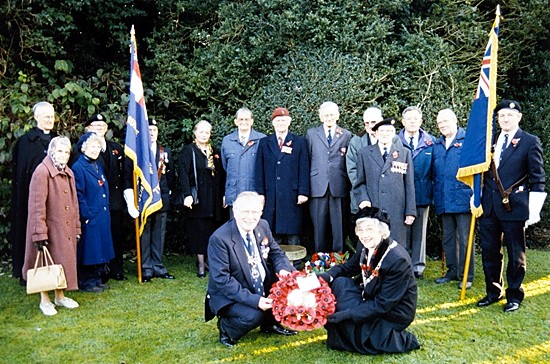 |
|
THE LEGION IN PAST TIMES |
|
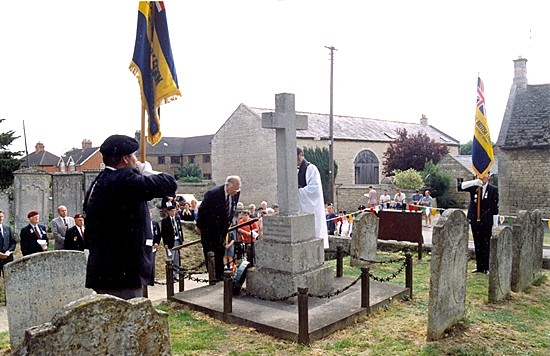 |
|
The 75th Royal British Legion anniversary
parade at Langtoft, near Bourne, on Sunday 14th July 1996, with
Councillor Don Fisher, chairman of the Bourne branch, laying a
wreath at the war memorial in the village churchyard. |
|
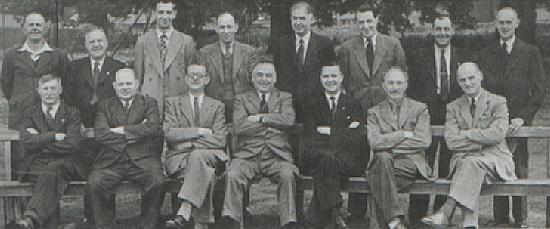 |
|
The committee of the
Bourne branch of the British Legion for 1950-51. They are
- back row, from the left, P Larkinson, L Kirkby, M Nixon, J
Parrish, S Nowell,
E Horn, E Lockwood, Colonel W R Myers;
front row, from the left, E Lane, C F Feetham (assistant
secretary),
J Walton (secretary), Captain G R Holliday (chairman),
C G Barr (vice-chairman), E Pattison (chairman, entertainments),
H R Greenwood (treasurer). |
|
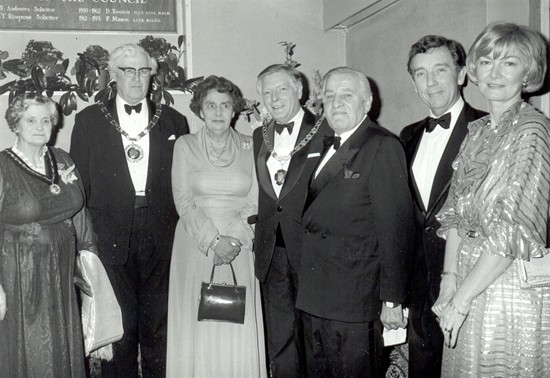 |
|
The appointment of president of the branch
has been filled over the years by many distinguished
ex-servicemen, among them Air Marshal Sir John Moreton Nicholls
who held office for three years from 1983. He had joined the Royal
Air Force in 1945 and went on to become one of their most
experienced fighter pilots, serving in Korea where he was awarded
the DFC and the American DFC for bravery. He was appointed CBE in
1967 and KCB in 1978 and after holding a number of senior posts,
he eventually became vice-chief of the Air Staff, leaving the
service in 1980 for a short spell with British Aerospace before
retiring in 1983 when he went to live at Morton, near Bourne. In
1946, he had married a local girl, Miss Enid Rose, daughter of Mr
Eric Rose of Spalding Road, Bourne, and they had two daughters,
but she died in 1975 and two years later he married Sheelagh Hall
with whom he lived at Morton until 1986 when they moved to
Norfolk.
He succeed the Earl of Ancaster as president of the Bourne branch
and during his time in office, took a keen interest in its affairs and in 1984, was one of the guests of
honour at the annual civic dinner and ball hosted by Councillor
Don Fisher, the Mayor of Bourne. He is pictured (centre) with
Councillor Dr David Harris, chairman of South Kesteven District
Council, and his wife Mary, Sir Kenneth Lewis M P, the member for
Stamford and Spalding, and Lady Lewis, and Sir John and Lady
Nicholls who are pictured on the right. Sir John died in 17th May
2007 aged 80. |
|
SERVICE OF RE-DEDICATION |
|
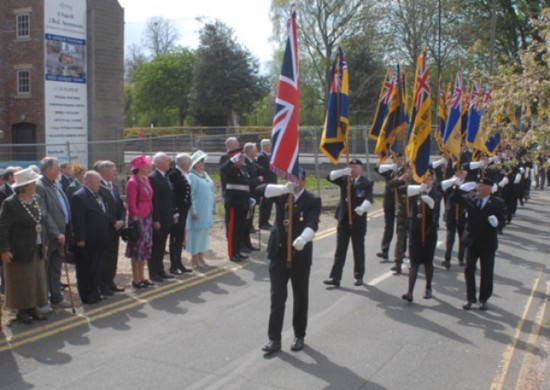 |
|
The Lincolnshire branch of the Royal British
Legion held its annual service of re-dedication in Bourne on Sunday
6th May 2012. The event was due to start with a wreath laying at the
war memorial in South Street but a week of rain meant the area was
too muddy. Instead, the 24 county standards were paraded from the
Darby and Joan Hall in South Street to the Abbey Church, where the
wreath was laid by the legion’s county chairman, Tony Goodwin, and
the legion president, Brigadier Barry Reeves. Afterwards, more than
150 people attended a service at the church conducted by Father
Chris Atkinson followed by refreshments in the church hall. Steve
Ironmonger, vice-chairman of the Bourne branch, said: “We couldn’t
carry out what we wanted to do because of the mud but it was sunny
on the day and overall, it went very well.” Among those present were
the Lord Lieutenant of Lincolnshire, Tony Worth, and Councillor
Brenda Johnson, the Mayor of Bourne. |
|
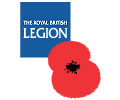 |
This
article has been compiled with information
from
the Royal British Legion Internet web site
and
a history of the Bourne branch
prepared
by Councillor Don Fisher
in
August 1994.
|
See also The War Memorial
Richard Pattison
Charles Sharpe VC

Go to:
Main Index Villages
Index
|








